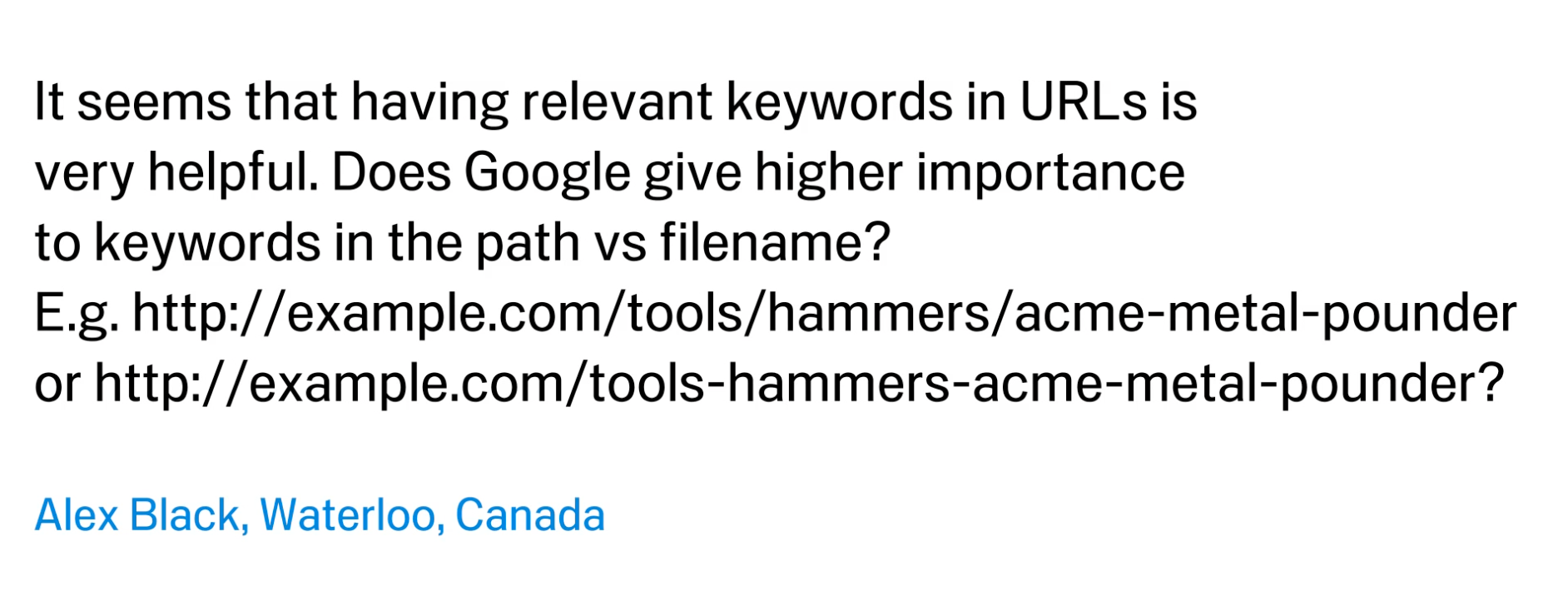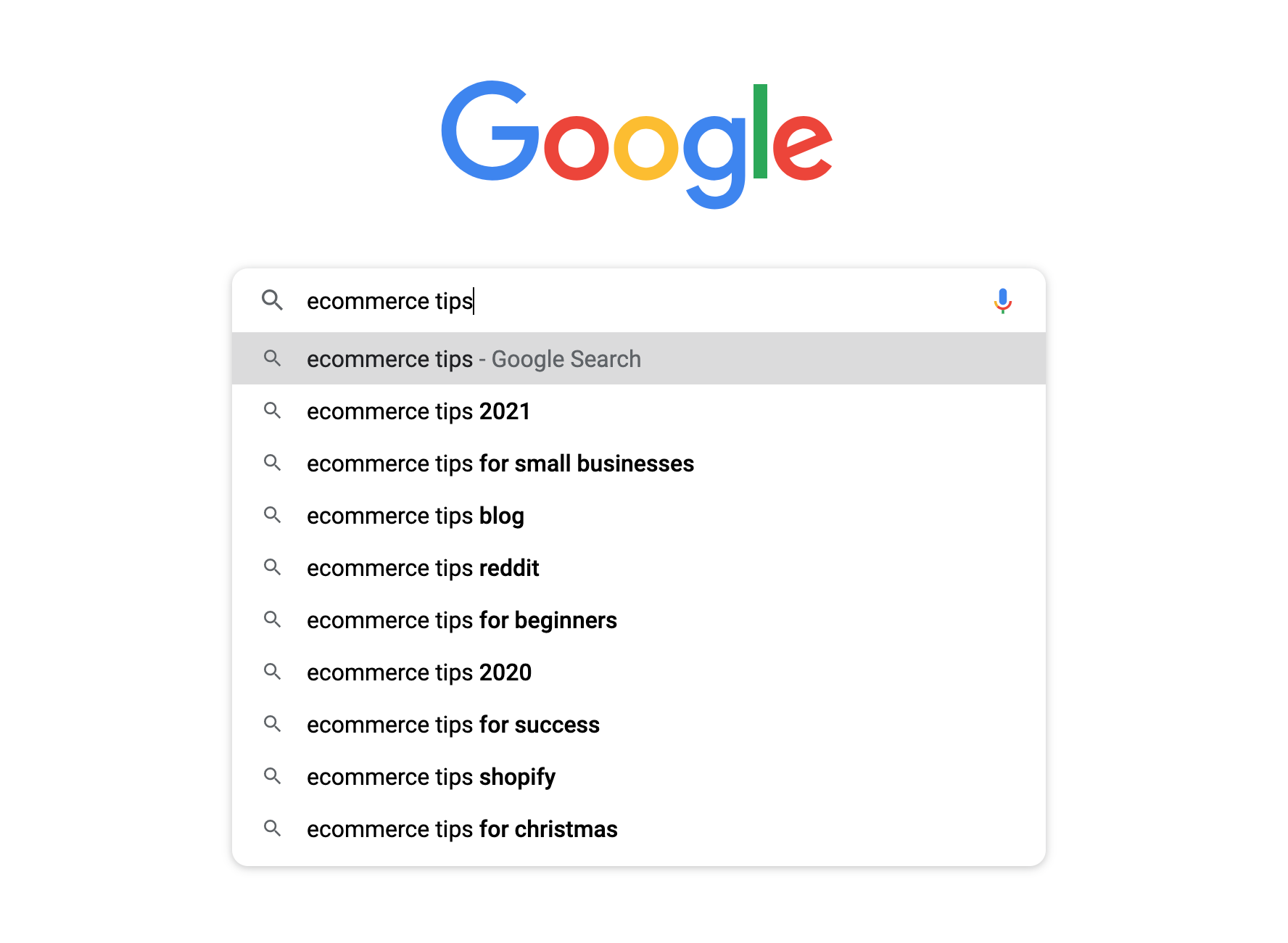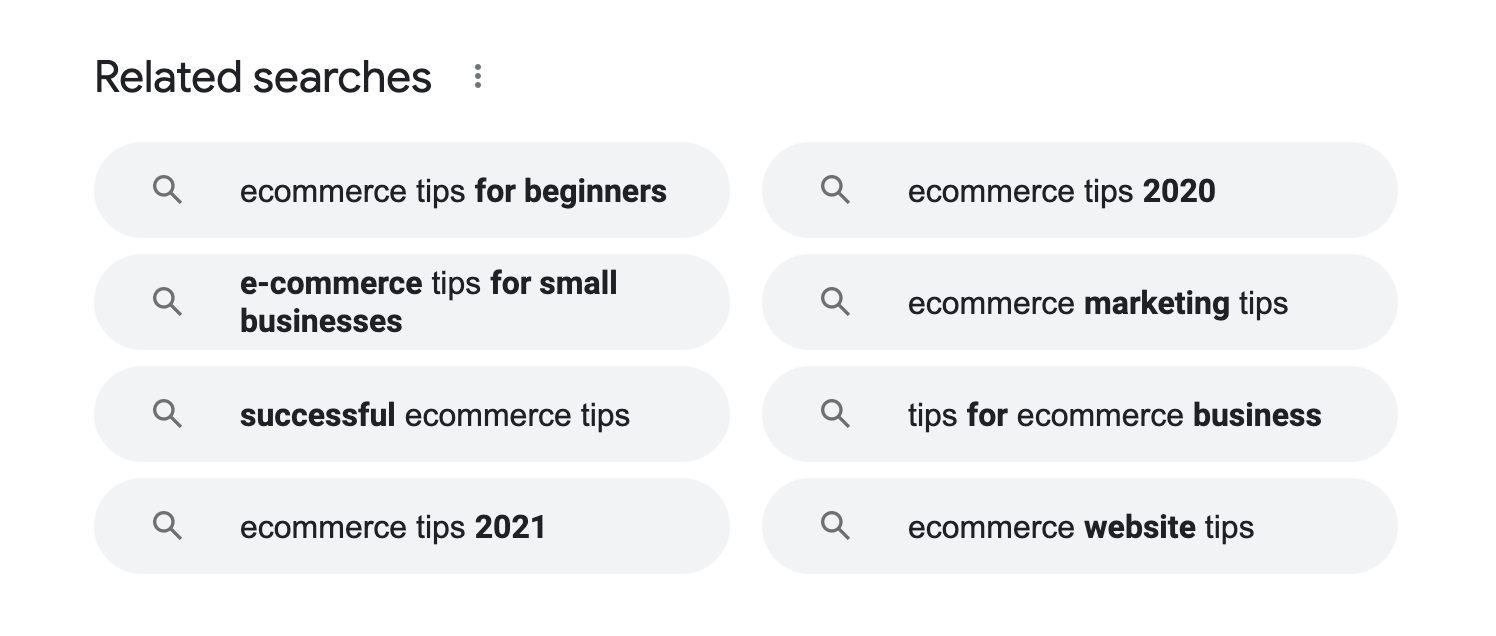When it comes to getting an ecommerce site to rank higher in search engine results, all anyone talks about is keyword this and keyword that.
Good content marketers realized long ago that keywords aren’t the sole route to survival in the SERPs. Great content, internal and external linking strategies, product taxonomies and even site structure all play a role.
Still, there’s this fascination with keywords – keywords in blogs, keywords in meta descriptions, keywords in product pages, headers and more.
But what about keywords in URLs?
Does placing keywords in your ecommerce URLs (product, category, and content marketing URLs alike) influence search engine results? And if so, how should you use them to your advantage?
We decided to find out.
Are Keywords in URLs a Ranking Factor?
Many ecommerce SEO experts suggest optimizing URLs with keywords. While it can boost URL ranking a little and is a tactic to take advantage of, it shouldn’t be the be-all and end-all of your URL strategy. Take, for example, how Google looks at keywords in a URL.
Both John Mueller, Google Webmaster Trends Analyst, and Matt Cutts, former head of webspam at Google, suggest that keywords in URLs can help but aren’t critical to ranking.
In a Google Webmaster hangout video from 2016, at the 17:50 minute mark, John Mueller responds to a question on keywords’ role in URL ranking:
“I believe that is a very small ranking factor, so it is not something I’d really try to force. And it is not something I’d say is even worth your effort to restructure your site just so you can get keywords in your URL.”
In response to a tweet regarding URL keywords a year later, John Mueller gets even more direct:
“Keywords in URLs are overrated for Google SEO. Make URLs for users.”

Meanwhile, when Matt Cutts’ speaks on the position of keywords in URL links (more on this below), he agrees that “It does help a little bit to have keywords in the URL.” Still, he shares the sentiment that users should always come first.
In concurrence, research from Moz back in 2014 found that the correlation between URL keywords and ranking was on the decline.
This decline is why we, among others, suggest mapping content with a focus on topics and taking a more value-oriented approach over SEO checklists. (You know, the ones that say you have to force a keyword in the title, a subheader, the conclusion, and 3 times throughout the content).
However, this doesn’t mean that there is no value in implementing a strategic URL keyword approach.
Google’s starter guide recommends using relevant words in URLs to make pages easier to use:
“URLs with words that are relevant to your site’s content and structure are friendlier for visitors navigating your site.”
Others have conducted small tests to weigh the effect for themselves.
One trial comparing the results of two made-up websites using a made-up keyword showed that while both ranked, the one with the keyword URL ranked above the other.
Tests like these don’t account for all ranking factors, but the results align with John Mueller’s and Matt Cutt’s statements that keywords have a minor influence on ranking.
In other words, do you need to put keywords in a url for SEO? No.
But can they help? Yes.
So, Should You Put Keywords in URLs?
Using keywords in URLs helps ecommerce SEO a little, but relevance and user-friendliness should always take priority. It also depends on the risk vs the reward: if you’re not starting from scratch, a keyword-based slug might help, but it’s not worth changing your entire URL structure.
Although keywords aren’t essential to rank, the benefits of using keywords in your URL include helping search engines understand page content and improving user-friendliness by keeping URLs short, focused and relevant.
Does a Keyword in the Domain Name Help SEO?
Having a keyword in the domain name can help SEO, but minimally. Matt Cutts announced in 2011 that Google would be turning down the ranking factor of keywords in domains. Then, in 2012, a Google algorithm update reduced low-quality exact match domains in search results.
An exact match domain (EMD) is a domain name that matches a keyword or search phrase exactly.
It is worth noting from an SEO perspective that using keyword domains can result in people linking to your website with the domain as anchor text, thus encouraging ranking for that keyword.
Even so, keyword domains tend to be less effective at standing out from the noise, whereas branded domains are memorable and distinct. Cutts points out that many large, successful brands aren’t keyword names.
So, are exact keyword domains worth it? Probably not.
We recommend using branded domains because domains that contribute to your brand will be critical to growth and establishing a loyal customer base in the long run, as well as help differentiate your business from competitors.
That’s not to say that there aren’t successful, living examples of keyword domains, like cheapflights.com. In this case, the domain at least does an effective job of establishing the website’s value proposition.
How Do I Add Keywords to My URL?
While adding keywords to URLs is a tactic worth utilizing, it’s not something you can do haphazardly. Some even say that using keywords in URLs is bad, but this is only if they become your sole focus and aren’t employed properly.
If you want to go the extra mile and use keyword URLs, start with these guidelines:
- Don’t keyword stuff. Keyword stuffing is the practice of forcing too many keywords into your URLs, and it only hurts SEO and readability. Users and search engines will have a harder time understanding your URL, and Google may even punish your page. As for how many keywords should be in a URL, add no more than one long-tail keyword or a couple of short-tail keywords in the slug.
- Aim for long-tail keywords. Long-tail keywords are those with four or more words, meaning they are more likely to match search queries. They are also specific, so users who search for them are looking for exactly what you offer. For ecommerce websites, long-tail keywords in URLs may work for landing pages, product pages and blog content but be too long for categories.
- Consider head keywords. Head keywords are usually short, competitive and high-volume keywords used to attract a lot of traffic. If your page is of high quality and covers a general topic comprehensively, a head keyword may be worth attempting to rank for. It’s common to use head keywords for pillar content. (Head keyword is also a term used to describe your main keyword for a page).
- Keep keywords relevant. Never choose a high-volume keyword at the expense of accuracy. Using relevant keywords in URLs is critical to user satisfaction and making sure search engines show your page for relevant queries. Placing number one for a keyword that isn’t relevant to your content won’t lead to conversions. Be sure to consider how users search; the words they use for a product may be different than what you would use.
- Keep navigation intuitive. Natural navigation is more important than keyword inclusion. When it comes to ecommerce sites, the keyword for a product or category page is often the name of the product or category – or a variant of it. This keeps it easy for users to understand the URL and navigate the site. For ecommerce URLs, make sure your product URLs don’t look like blog URLs.
You’ll also want to make sure you keep track of the slugs you write and the top keyword you use in each URL. You can only use slugs once, and trying to rank multiple pages for the same keyword can result in keyword cannibalization.
How Do I Use Keywords Throughout a URL?
When using keywords in a URL, limit yourself to one long-tail keyword or one to two short-tail keywords to prevent stuffing and protect readability. When it comes to how to arrange keywords in URLs or the depth of keywords in the URL path, it doesn’t matter too much what you do.

In a video on the position of URL keywords, Matt Cutts explains that it’s not worth worrying about:
“I wouldn’t really obsess about it at that level of detail… If there’s a convenient way that’s good for users where you have four or five keywords that might be worthwhile, but I wouldn’t obsess about it to the level of, you know, how deep is the URL in the path or, you know, how am I combining it.”
He shares that, with his blog, he looks at a post and uses the first two to five words related to it.
We recommend optimizing your URL paths to mimic your website navigation within reason. Doing so will help search engines and users understand the context of your ecommerce pages and help savvy users find what they are looking for.
In another video, Cutts addresses using keywords throughout the URL path vs within the filename.

In this case, he also implies that it doesn’t impact SEO or ranking either way. Instead, he encourages taking the user’s perspective. What is the page about, what is its context within your website, and how will users perceive the URL?
Cutts does point out that if there’s a clear category delineation, slashes look better and are clearer to users than a series of hyphens.
We agree as ecommerce pages typically have a clear delineation, and it makes website navigation transparent. However, this only works if the URL path follows your website’s navigation.
For instance, if you use the slashes example http://example.com/tools/hammers/acme-metal-pounder, some users will expect that they can shorten the URL to http://example.com/tools/hammers/ to see all of your hammers.
How to Find Keywords for a URL
Finding the right keywords is also a critical component of any URL strategy.
A great way to start your research is to see what keywords you and your competitors are already ranking for. Doing so gives you an idea of what works and where search engines place your expertise.
With a keyword tool like Ahrefs, look at what keywords top pages like yours are ranking for. One way to do this is to look up queries related to your product or titles similar to yours to find the top pages. Then look up the keywords those pages rank for. (With Ahrefs, you can do this with Site Explorer when you specify URL and view organic keywords).
If you have keywords in mind, you can do a keyword search, and Ahrefs will show you the top 10 pages ranking for the term. You can then use the above process with these pages.
If you don’t have a keyword tool, consider referencing Google’s automated suggestions when you start typing in a title or query. Just make sure you turn personal results off, or Google will base them on your search history.

Some specialists also recommend looking at Google Search ads. When you look up a query, these ads appear at the top of the search results and may include quality keywords.
We recommend looking at the “People also ask” section and the related searches towards the bottom of the SERPs in Google.

You can also scour high-ranking landing pages that are likely to include keywords in them.
While it’s possible to conduct keyword research using tactics like these, investing in a tool like Ahrefs or an agency that handles SEO streamlines the process and provides more accurate results.
How to Select URL Keywords for Ecommerce Pages
Once you’re ready, compile a list of keywords relevant to the topic of your page.
It’s often a good idea to prioritize descriptive, long-tail keywords, but this will depend on your content. Informational pages, like blog posts, are great for long-tail keywords because they can more accurately target user questions. Product pages, however, should use the keyword most relevant to the product and that targets users ready to buy (with transactional search intent).
There are four types of search intent for keywords:
- Informational: The user is looking for information. Think whos, whats, whens, wheres, whys and how-tos.
- Navigational: The user is looking for a specific page. These searches are often branded, like “Facebook login.”
- Commercial: The user is doing their research before buying a product.
- Transactional: The user is ready to buy.
Informational keywords are used for blogs because the user is looking for information. Transactional keywords are best for ecommerce product pages because they indicate that the customer knows exactly what they want and is ready to buy.
Always target keywords in page URLs with search intent in mind. You can test search intent for keywords by looking at the pages ranking for them. If you’re choosing a keyword for a product page, and the pages that rank for that keyword are blog posts, it’s probably not the best choice.
Another way to narrow down your keywords is by search volume, CPC and difficulty.
A high CPC (cost-per-click) means that advertisers find the keyword valuable and often commercial or transactional. The higher the CPC, the more valuable the keyword and, likely, the harder it will be to rank for it.
Keyword difficulty, offered by tools like Ahrefs, estimates how hard it is to rank for a given keyword. You want the difficulty to be as low as possible, but don’t let it hold you back if you have great content.
And then there’s search volume – the one that gets all the glory. A high search volume indicates a lot of traffic, so many focus on selecting keywords with the highest volume. This isn’t always the best strategy.
What Is a Good Keyword Volume?
A high search volume of 400 or even 10,000 may sound nice, but the right keyword volume depends on your goals. Using a high-traffic keyword won’t matter if it’s too hard to rank for or the queries it ranks for don’t match search intent.
The sweet spot is a keyword with a high search volume, high CPC and low difficulty. These words are hard to find because the popularity of high-search-volume words makes them more competitive.
Thus, the challenge is striking a balance.
When you find words with an extremely high volume, look at the top 10 sites on Google ranking for the word, and evaluate your likelihood of ranking. Using too many competitive keywords and too few long-tail keywords are common causes of not showing up in search.
URL Keywords Aren’t the Be-All and End-All
Giving ecommerce URLs a boost with well-thought-out keywords is a good idea, but it isn’t everything. As Google’s engineers and any good marketing specialist will tell you: the consumer (or user) comes first.
And while using SEO keywords in URLs may help to rank, they aren’t critical to success. Providing trustworthy links and an easy-to-navigate website are. Keep this in mind when evaluating the worth of a keyword in your URL.


